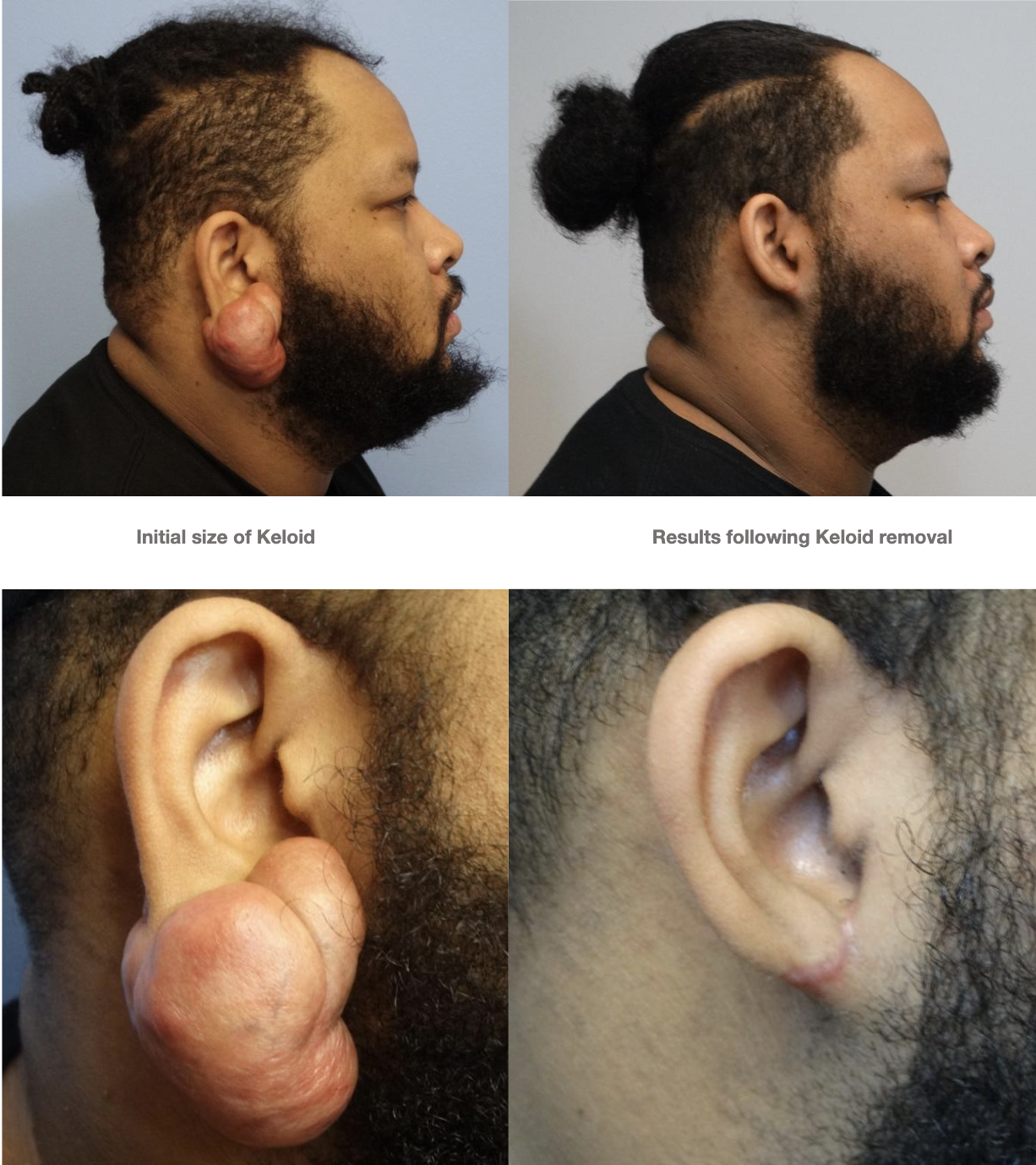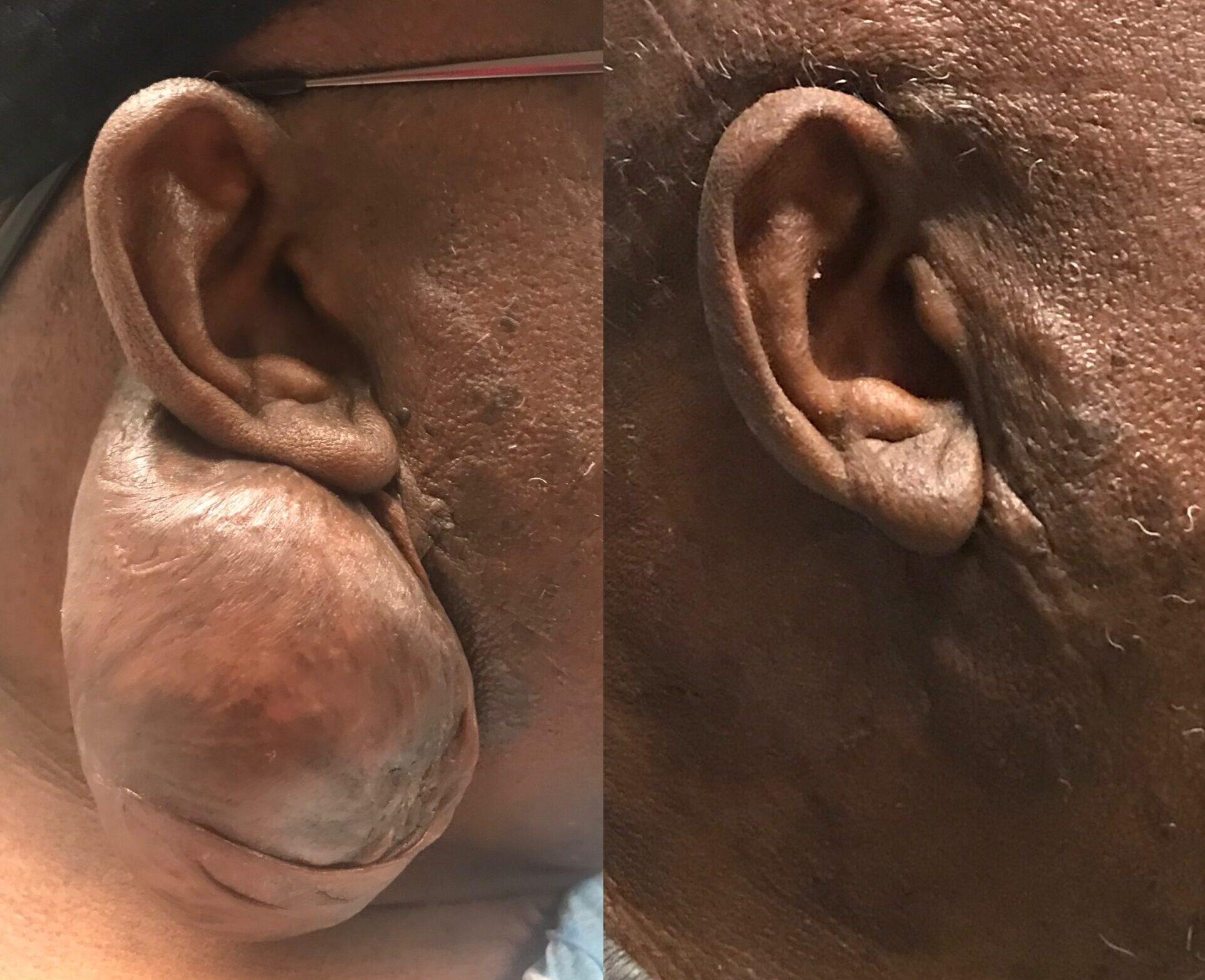Injuries from Pierced Ears
Body modification, including piercing and tattooing, has become commonplace in recent years. With the increasing popularity of body art comes an increasing frequency of complications, including stretched or torn earlobes, keloid scars, and unwanted tattoos. Fortunately, most of these problems can be addressed with laser treatment or minor plastic surgery.
Keloid Scars
Keloids are benign tumors caused by an excessive proliferation of scar tissue. Normal scars flatten and soften over time, eventually fading to a near normal color, texture, and consistency matching the surrounding tissue. If a scar proliferates and thickens, it is called a hypertrophic scar. A keloid is distinguished from a hypertrophic scar because the keloid grows beyond the size of the original injury.
As with all scars, keloids are caused by injury to the skin (typically through piercings). There is a strong genetic predisposition for forming keloids, particularly in people with African heritage. Keloids are commonly seen on the ears, where they may be stimulated by irritation from the earring or infection of the original piercing. It is extremely common to see multiple keloids on the same person. People with a history of keloids are advised to avoid further piercings and unnecessary body modifications.
Repair Process
Keloid scars are usually removed in the office under local anesthesia.
Step 1 – A small flap of skin is raised around the edge of the keloid and then the abnormal scar tissue is surgically removed.
Step 2 – The skin is artfully trimmed and folded to cover the defect and then repaired with fine sutures.
The sutures are usually removed in less than a week to avoid creating a foreign body reaction to the suture material.
Next Steps
Steroids and pressure earrings may be used to reduce small keloids, or to prevent regrowth of keloids. For small keloids on the earlobe, clip-on earrings may be modified by gluing a dime to one or both sides of the clip creating a broad, flat surface area that applies direct pressure to the keloid.
The physician often recommends injections of a long acting steroid such as triamcinolone directly into the scar at 6-12 week intervals. Over the course of a year or more, and the repair will often heal, and further injections may be unnecessary.
Should the keloid begin to grow again, it is most helpful to return to the physician and intervene early rather than to wait for the keloid to become large.
Torn or Stretched Earlobes
It is common for heavy earrings to stretch or tear through the ear lobe, creating a cleft lobule. Most patients come to the office after the ear lobe tear has already healed. Sometimes, the piercing in the ear lobe was never torn, but simply stretched by the weight of the earring or dilated by the use of progressively larger gauges. 
Repair Process
Earlobe deformities can usually be repaired under local anesthesia in the office.
Step 1 – The skin that is lining the defect is removed, so that the raw surfaces can heal together
Step 2 – The earlobe may be trimmed to a satisfactory size and shape before it is repaired. Usually, a small zigzag pattern called a Z-plasty is created at the edge of the earlobe to reduce the chance of notching. This helps hide the scar.
Next Steps
We recommended waiting 3-6 months before piercing the earlobe in or near the repaired site.
It is important to remember that a healing wound is always weaker than the previously healthy skin that has been torn.
Associated Fees
The repair of torn earlobes, stretched or dilated piercings, and keloids that are associated with ear piercing or other forms of body modification is considered cosmetic.
Medicare and insurance companies do not pay for ear piercing, which they consider a cosmetic surgery, nor do they pay for correction of injuries that are clearly the result of a previous cosmetic surgery, such as an ear piercing. The cost of repairing keloids and earlobe tears in the office typically ranges from $500-$1000, depending on the size and complexity of the injury.
Potential Risks
Most procedures are painless after the introduction of local anesthesia, and postoperative pain can often be managed without narcotic pain medications.
The external ear generally has an excellent blood supply and heals well after minor injury or surgery. Infections and failure to heal are therefore rare. However, the cartilage of the ear has no blood supply of its own, so the potential for infection or poor healing is greater when cartilage has been pierced or injured.
Scarring is inevitable with any surgery.
The risk of re-injury or regrowth of a keloid is much greater if the ear is pierced again.
Other Types of Plastic Surgery to the Ears
Otoplasty is the cosmetic correction, or “pinning back,” of ears that stick out too far.
Skin cancer is the most common cause of damage to the ears, but modern reconstructive techniques can often restore a nearly normal shape and function.
Cauliflower ears are deformities that result from mechanical injuries to the ear, most commonly during the sport of wrestling.
Microtia and aural atresia is a rare congenital deformity in which a child is born without normal ear cartilage and without an ear canal


